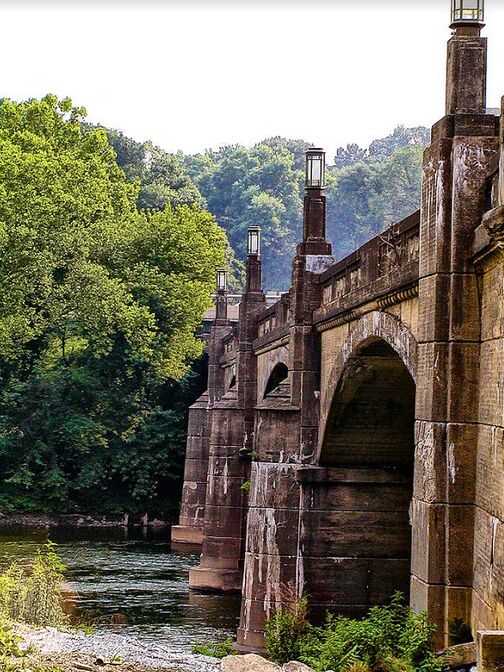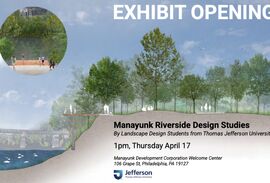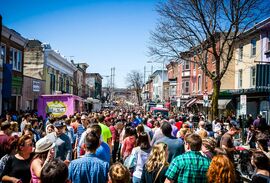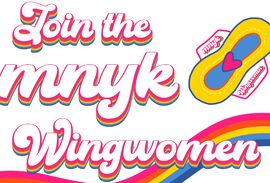WHAT'S HAPPENING: Everything Is Illuminated

By Jane Lipton
Quietly and without much fanfare, something special happened to historic Manayunk this September. Not a big event the town has become known for, or something as spectacular as the opening of the Manayunk Bridge Trail—it was something subtle, but important.
This fall, the Green Lane Bridge got a little bit brighter. It's easy to miss, but thousands of cars drive over this small and often overlooked bridge every day—it's the one that connects Main Street to Belmont Avenue and the Schuylkill Expressway. Enthusiasts of Philadelphia architecture may know it as one of the Paul Cret (pronounced 'Cray') bridges.

Originally constructed in 1928, the plans included 14 six-foot-tall art deco light fixtures. Sometime later, likely the 1950s, the city decided that upkeep was too expensive and all of the lights were discarded. In their stead, the city placed standard highway cobra head lamps atop each pillar. Then in 1983, when the entire commercial district in Manayunk was placed on the register of historic places, residents and business owners started talking about restoring the bridge lights back to the original. In 1997, with financial support from the Rendell administration, the dollars were finally allocated to recreate the lights which were redesigned from old photographs.
Even though things seemed ready to go, it was still not quite a “done deal.” Agreements had to be reached on light intensity and maintenance, as PennDOT claimed the Green Lane Bridge was a state road so it had to meet illumination levels for driver safety. The Philadelphia Streets Department said they preferred the cobra heads for ease of maintenance and that the new lights were non-conforming—therefore they were not responsible for maintenance. After much back and forth, both agencies eventually accepted the lights and the city and state agreed that they would pay for the electric, while Manayunk would pay for maintenance.
Over the years as the lights needed repair, the Manayunk Development Corporation (MDC) and Manayunk Special Services District (MSSD) hired private firms to do the work on a piecemeal basis. But even with the best of intentions, by 2012 more than half of the lights were out of commission and the remaining lights had a large variety of replacement lamps installed. Some lights looked yellow, some looked blue, and some were even a strange shade of orange. As one business owner described it, they looked "terrible.”
MDC began making inquiries to the City about how the lights could be replaced, and it wasn’t that anyone was particularly opposed to the idea, but after two years of emails and phone calls, it became apparent that no municipal or state entity felt that it was their responsibility. Finally, in 2014 at an MSSD board meeting, it was decided that the organization would have to take on the project themselves.

“It had to be done,” Martin Pulli, an MSSD board member and local business owner said. “The lights desperately needed work and I’m proud that we stepped up to do it with our own money.”
First, they had to find a lighting consultant. After researching the 1997 build, MSSD was connected with Courtney Sarge from Streamlight Design, who had worked on the original project. Once the project manager was in place, they formed a committee that would determine the wants and needs for the lights, and just as importantly, what they could afford.
For a moment, there was an idea of fully programmable, multi-colored internal lights reflecting the seasons or various causes—but alas, that idea was too expensive. MSSD then agreed to have the retrofit done with LEDs, not only for energy conservation but for optimal brightness and color. They also decided to add an outlet to each fixture for future enhancements. After a competitive bid process, Carr and Duff (oddly the company that did the 1997 installation) won the contract and the fabrication of the new light kits began. The retrofit install began in late August of this year and was nearly completed in under two weeks. The entire project was 100 percent finished by late September.
All in all, the project took a little less than two years and $70,000 of MSSD funds to complete. The lights look beautiful and are brighter than ever. And, of course, the bridge has now been brought back to a safe level of illumination. Local business owners are quite pleased and we think Paul Cret would be too.
“We could not be more thrilled to see The Green Lane Bridge, which serves as the gateway to Manayunk, so beautifully lit up,” said Daniel Neducsin, board chair of the MSSD.

Fun Facts:
The Green Lane Bridge is not Paul Cret’s only Philadelphia Bridge. His other bridge designs include the gorgeous Henry Avenue Bridge that crosses high over Lincoln Drive, the University Avenue Bridge more commonly called The Gray's Ferry Bridge, and the famous Benjamin Franklin Bridge. Imagine, Manayunk as a sister bridge to the mighty Ben Franklin!
With Jacques Greber, Cret co-designed the Benjamin Franklin Parkway and the Rodin Museum. He also designed the original Barnes Gallery and the home of Alfred Barnes in Merion.
Paul Cret was born in France in 1876 and moved to Philadelphia in 1903 after being recruited by the University of Pennsylvania to teach architecture. He was a professor and had a design studio there until 1937. Cret was an American Institute of Architects Gold Medal Winner.
One of Cret’s most famous students and protégés was famed Philadelphia architect Louis Khan.
Paul Cret designed in a new style he called “Neo Classicism” or “Stripped Down Classicism.” This style used clean geometric lines and monumental forms, which were widely studied in Germany in the 1930s. In 1935, Albert Speer, who was appointed by Adolph Hitler to be the official architect of the Third Reich, designed a colonnade of square monument-like piers for the Zeppelinfield Stadium that directly referenced Cret. This stadium design ultimately became the signature style of the Third Reich. Ironically, Fascism was the antithesis of what Cret’s new design aesthetic was about--capitalism and American exceptionalism. Nonetheless, Cret's design styles were associated with the Nazis and quickly fell from favor here in the U.S. Cret continued to work, but his designs mirrored more colonial and classic roman columnar forms later in his life.
Writer’s Note: I am a lifelong fan of design and architecture. This entire process has been a pleasure for me. I’m glad I was able to be part of the restoration of a landmark I have known my entire life. The Paul Cret-designed Green Lane Bridge is part of Historic Manayunk and is listed on the City of Philadelphia’s Register of Historic Places.
Recent Posts
-
Get ready, foodies! The Manayunk StrEAT Food Festival is back and tastier than ever. This beloved event transforms the charming Main Street in Manayunk, Philadelphia into a vibrant outdoor food market filled with mouthwatering eats, local vendors, and family fun. Whether you’re a die-hard foodie or just looking for a fun day out, this festival is a can’t-miss.Apr 09, 2025
-
As the chill of winter fades and the sun starts shining a little brighter, Manayunk transforms into a lively hub of food, fun, and fashion. Spring is the perfect time to explore this charming Philadelphia neighborhood, whether you're indulging in seasonal bites, enjoying alfresco dining, or shopping for unique finds at local boutiques. Here’s your ultimate guide to experiencing the best of Manayunk this spring!Apr 02, 2025
-
Manayunk's woman-owned businesses have teamed up as "The Manayunk Wingwomen" for the 4th Annual Manayunk Wingwomen Initiative!Mar 04, 2025
Comments1
- 1




Jane;
Yourself, the MDC board ( on which I proudly served) and the MDC staff did a wonderful job of getting the bridge back to it's original stately appearance. With the addition of holiday wreaths and bright new lights it provides a great gateway to our shopping district!